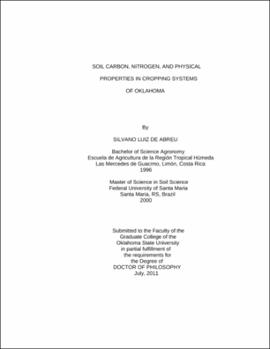| dc.contributor.advisor | Edwards, Jeffrey T. | |
| dc.contributor.author | Abreu, Silvano Luiz de | |
| dc.date.accessioned | 2013-12-10T18:04:29Z | |
| dc.date.available | 2013-12-10T18:04:29Z | |
| dc.date.issued | 2011-07 | |
| dc.identifier.uri | https://hdl.handle.net/11244/7715 | |
| dc.description.abstract | Scope and Method of Study: | |
| dc.description.abstract | Soils across the State of Oklahoma where areas of conventional and long term no-till are under similar climate conditions and soil properties (same soil series) were sampled in 4 points of a transect across the field at 110 cm depth and divided in 5 different depths (0-10; 10-20; 20-40; 40-70; and 70-110 cm). Samples were air dried and sieved at 2mm mesh. Sixteen farm fields (eight no-till and eight conventional till) were sampled in the principal agricultural areas of Oklahoma. Also, two tillage experiments that have no-till and conventional till treatments combined with different crop rotations where sampled and compared as well. Organic C and total N were analyzed. Besides, bulk density was determined at each depth and sampling point in order to account for the amount of organic carbon and nitrogen storage in the soil profile. Results were analyzed by LSD comparing tillage system. Organic carbon and total nitrogen was analyzed by LECO analyzer and carbonates were analyzed so the amount of organic carbon can be calculated. Another chapter of the study analyzed the use of cover different cover crops; including forage radish, sunn hemp, pigeon pea, cowpea, and Austrian winter pea in cash crop rotations that included soybean, corn, and wheat. Grain yield, biomass, and soil physical properties were analyzed in two locations in Central Oklahoma. | |
| dc.description.abstract | Findings and Conclusions: | |
| dc.description.abstract | For most Oklahoma studied areas, no-till soils had higher organic carbon and total nitrogen stock in the soil profile than conventional till. Top soils no-till have also more carbon stock in no-till compared to conventional till soils. The increasing of crop intensity and diversity did not affect grain yield in the cash crops, but increased biomass production. After two years of rotations no effect of crop rotation or crop intensity was observed in soil physical properties. | |
| dc.format | application/pdf | |
| dc.language | en_US | |
| dc.rights | Copyright is held by the author who has granted the Oklahoma State University Library the non-exclusive right to share this material in its institutional repository. Contact Digital Library Services at lib-dls@okstate.edu or 405-744-9161 for the permission policy on the use, reproduction or distribution of this material. | |
| dc.title | Soil carbon, nitrogen, and physical properties in cropping systems of Oklahoma | |
| dc.contributor.committeeMember | Godsey, Chad B. | |
| dc.contributor.committeeMember | Klatt, Arthur R. | |
| dc.contributor.committeeMember | Warren, Jason G. | |
| dc.contributor.committeeMember | Tyagi, Avdhesh K. | |
| osu.filename | Abreu_okstate_0664D_11504.pdf | |
| osu.accesstype | Open Access | |
| dc.type.genre | Dissertation | |
| dc.type.material | Text | |
| dc.subject.keywords | carbon sequestration | |
| dc.subject.keywords | cover crop | |
| dc.subject.keywords | crop rotation | |
| dc.subject.keywords | no till | |
| dc.subject.keywords | oklahoma | |
| dc.subject.keywords | soil physics | |
| thesis.degree.discipline | Soil Science | |
| thesis.degree.grantor | Oklahoma State University | |
